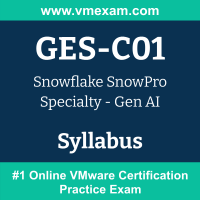 The Snowflake GES-C01 exam preparation guide is designed to provide candidates with necessary information about the SnowPro Specialty - Gen AI exam. It includes exam summary, sample questions, practice test, objectives and ways to interpret the exam objectives to enable candidates to assess the types of questions-answers that may be asked during the Snowflake Certified SnowPro Specialty - Gen AI exam.
The Snowflake GES-C01 exam preparation guide is designed to provide candidates with necessary information about the SnowPro Specialty - Gen AI exam. It includes exam summary, sample questions, practice test, objectives and ways to interpret the exam objectives to enable candidates to assess the types of questions-answers that may be asked during the Snowflake Certified SnowPro Specialty - Gen AI exam.
It is recommended for all the candidates to refer the GES-C01 objectives and sample questions provided in this preparation guide. The Snowflake SnowPro Specialty - Gen AI certification is mainly targeted to the candidates who want to build their career in Specialty domain and demonstrate their expertise. We suggest you to use practice exam listed in this cert guide to get used to with exam environment and identify the knowledge areas where you need more work prior to taking the actual Snowflake SnowPro Specialty - Gen AI exam.
Snowflake GES-C01 Exam Summary:
| Exam Name | Snowflake SnowPro Specialty - Gen AI |
| Exam Code | GES-C01 |
| Exam Price | $225 USD |
| Duration | 85 minutes |
| Number of Questions | 55 |
| Passing Score | 750 + Scaled Scoring from 0 - 1000 |
| Recommended Training / Books |
Snowflake Gen AI Training SnowPro Speciality: Gen AI Study Guide |
| Schedule Exam | PEARSON VUE |
| Sample Questions | Snowflake GES-C01 Sample Questions |
| Recommended Practice | Snowflake Certified SnowPro Specialty - Gen AI Practice Test |
Snowflake SnowPro Specialty - Gen AI Syllabus:
| Section | Objectives |
|---|---|
Snowflake for Gen AI Overview - 26% |
|
| Define Snowflake’s Gen AI principles, features, and best practices. |
- Snowflake Cortex
- Snowflake Copilot
- Different interfaces
- Different ways of bringing your own models into Snowflake (for example, from Hugging Face)
|
| Outline Gen AI capabilities in Snowflake. |
- Cortex LLM functions (for example, task-specific, general)
- Cortex Search
- Cortex Analyst
- Cortex Agents (Public Preview)
- Cross-region inference
|
Snowflake Gen AI & LLM Functions - 40% |
|
| Apply Gen AI and LLM functions in Snowflake. |
- Snowflake Cortex
- Cortex Search
- Helper functions
- Choosing a model
|
| Perform data analysis given a use case. |
- Use fully-managed LLMs, RAG, and text-to-SQL services
- Performance considerations
|
| Build chat interfaces to interact with data in Snowflake. |
- Set up the Snowflake environment
- Invoke Cortex functions within the application code (for example, Streamlit)
|
| Use Snowflake Cortex functions in data pipelines. |
- Snowflake Cortex
|
| Run third-party models in Snowflake. |
- Using Snowpark Container Services
- Using the Snowflake Model Registry
|
Snowflake Gen AI Governance - 22% |
|
| Set up model access controls. |
- Limits on which models can be used
- Data safety and security considerations
- REST API authentication methods |
| Set guardrails to filter out harmful or unsafe LLM responses. |
- Cortex Guard
- Methods to reduce model hallucinations and bias |
| Monitor and optimize Snowflake Cortex costs. |
- Cortex Search
- Cortex Analyst
- Cortex LLM functions
- Tracking model usage and consumption
|
| Use Snowflake AI observability tools. |
- Snowflake AI observability (Public Preview) features
- Implementation methods
|
Snowflake Document AI - 12% |
|
| Set up Document AI. |
- Virtual warehouse, database, and schema considerations - Roles and privileges
|
| Prepare documents for Document AI. |
- Upload documents - Train the model - Requirements (for example, formats, size limits) - Question optimization best practices |
| Extract values from documents using Document AI. |
- Conditions - <model_build_ name>!PREDICT query - Automation of data pipelines |
| Troubleshoot Document AI given a use case. |
- Extracting query errors - GET_PRESIGNED_URL function - Requirements and privileges - Cost and best practices considerations |
